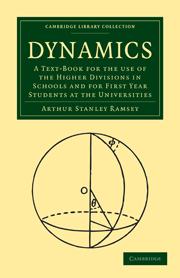 Dynamics
Dynamics Book contents
- Frontmatter
- PREFACE
- Contents
- Chapter I INTRODUCTION
- Chapter II VECTORS
- Chapter III RECTILINEAR MOTION. KINEMATICS
- Chapter IV RECTILINEAR MOTION. KINETICS
- Chapter V KINEMATICS IN TWO DIMENSIONS
- Chapter VI DYNAMICAL PROBLEMS IN TWO DIMENSIONS
- Chapter VII HARMONIC MOTION
- Chapter VIII MOTION UNDER CONSTRAINT
- Chapter IX THE LAW OF REACTION. GENERAL PRINCIPLES
- Chapter X GENERAL PROBLEMS
- Chapter XI IMPULSIVE MOTION
- Chapter XII POLAR COORDINATES. ORBITS
- Chapter XIII MOMENTS OF INERTIA
- Chapter XIV MOTION OF A RIGID BODY. ENERGY AND MOMENTUM
- Chapter XV EQUATIONS OF MOTION OF A RIGID BODY
- Chapter XVI MISCELLANEOUS PROBLEMS
- Chapter XVII SMALL OSCILLATIONS
Chapter XIV - MOTION OF A RIGID BODY. ENERGY AND MOMENTUM
Published online by Cambridge University Press: 07 September 2010
- Frontmatter
- PREFACE
- Contents
- Chapter I INTRODUCTION
- Chapter II VECTORS
- Chapter III RECTILINEAR MOTION. KINEMATICS
- Chapter IV RECTILINEAR MOTION. KINETICS
- Chapter V KINEMATICS IN TWO DIMENSIONS
- Chapter VI DYNAMICAL PROBLEMS IN TWO DIMENSIONS
- Chapter VII HARMONIC MOTION
- Chapter VIII MOTION UNDER CONSTRAINT
- Chapter IX THE LAW OF REACTION. GENERAL PRINCIPLES
- Chapter X GENERAL PROBLEMS
- Chapter XI IMPULSIVE MOTION
- Chapter XII POLAR COORDINATES. ORBITS
- Chapter XIII MOMENTS OF INERTIA
- Chapter XIV MOTION OF A RIGID BODY. ENERGY AND MOMENTUM
- Chapter XV EQUATIONS OF MOTION OF A RIGID BODY
- Chapter XVI MISCELLANEOUS PROBLEMS
- Chapter XVII SMALL OSCILLATIONS
Summary
14·1. A rigid body means a body in which the distance between each pair of particles remains invariable. The bodies with which we are familiar are all more or less elastic and capable of compression, extension or distortion under the action of external forces, and the problem of the motion of such a body is in general rendered more complicated by its deformability. The problem of the motion of bodies is greatly simplified by the hypothesis that they are rigid in the sense denned above, and in elementary dynamics we limit our considerations for the most part to the problem of the motion of one or more such bodies.
Further, we regard a rigid body as an agglomeration of particles held together by cohesive forces such that the action and reaction between any pair of particles are equal and opposite
(9.7), and we use the principles established in Chapter IX for the motion of a system of particles. In the case of the rigid body however there is an additional fact to be observed, namely, that since the distance between each pair of particles is unaltered in any displacement of the body, therefore the total work done by the action and reaction between the particles is zero.
- Type
- Chapter
- Information
- DynamicsA Text-Book for the Use of the Higher Divisions in Schools and for First Year Students at the Universities, pp. 197 - 207Publisher: Cambridge University PressPrint publication year: 2009First published in: 1929


